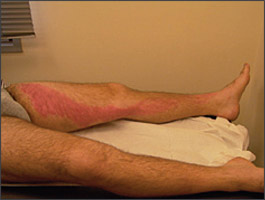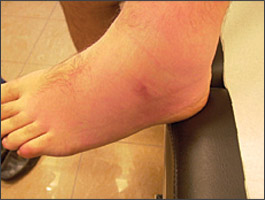
Am Fam Physician. 2006;73(6):1061-1062
A 24-year-old man presented with fever and redness of the left lower extremity. He reported an “insect bite” on his left foot two days earlier. Use of a local antiallergy ointment at the site had not improved his symptoms. He developed fever and chills two days after the bite. He also felt a burning sensation on his left leg. Physical examination showed a temperature of 101.7°F (38.7°C). The remaining vital signs and results of physical examination were normal except for his left leg. He had an extensive area with redness, palpable warmth, and tenderness extending from the foot to the upper part of the thigh (Figure 1). On the lateral surface of the left ankle there was a small area of necrosis at the site of the reported bite (Figure 2). In addition, there were palpable, tender lymph nodes in the left inguinal area. His white blood cell count was 12.7 × 109 per L (neutrophils, 81.5 percent; lymphocytes, 11.9 percent). The rest of the hematologic and biochemical test results were normal.


Question
Discussion
The answer is E: lymphangitis. Symptoms of linear erythema, fever, and chills support the diagnosis of lymphangitis. In addition, the presence of an initiating lesion (i.e., area of the insect bite) and tender inguinal lymph nodes makes an infectious etiology of the inflammation more likely than a noninfectious etiology (e.g., superficial thrombophlebitis).1,2
Acute lymphangitis usually is caused by beta-hemolytic Streptococcus group A (Streptococcus pyogenes). Rare causes include other groups of Streptococci, Staphylococcus aureus, Pasteurella multocida and Spirillum minus (rat-bite fever). The etiologic agents of acute lymphangitis are different from those noted in patients with chronic lymphangitis, in whom parasitic (usually filariasis) and fungal (usually sporotrichosis) infections predominate.
Erysipelas and cellulitis are localized skin infections. Lesions are edematous and indurated. Patients with erysipelas usually have a clear, well-demarcated margin between the inflamed and noninflamed skin and subcutaneous tissue.3 In contrast, cellulitis affects subcutaneous skin layers.4 Erysipelas and cellulitis may have associated fever, leukocytosis, lymphadenopathy, as well as lymphangitis. Thus, lymphangitis often coexists with erysipelas.4
The absence of an indurated major saphenous vein makes thrombophlebitis less likely than lymphangitis.1 The distribution of the erythema also makes an allergic reaction to an insect bite less likely; a wheal and flare reaction would be expected.5 Furthermore, the time of symptom presentation was not typical for allergic reaction, in which symptoms usually present within 24 hours after an insect bite.
| Condition | Characteristics |
|---|---|
| Superficial thrombophlebitis | Erythema and induration of the involved vein |
| Cellulitis | Lesions are rarely streaky; affects deeper layers of the skin; skin infection affects superficial and subcutaneous layers |
| Erysipelas | Affects superficial skin layers; well-demarcated margin between inflamed and noninflamed skin |
| Allergic reaction to insect bite | Highest intensity of inflammation is at the point of the insect bite |
| Lymphangitis | Linear, streaky, erythematous lesions; often an initiating lesion (e.g., insect bite) or skin infection is present. |